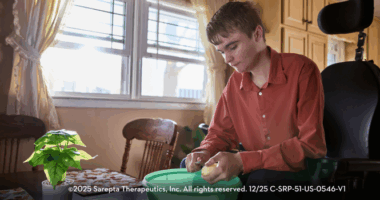How I fully embrace life with limb-girdle muscular dystrophy
Setting goals, adapting, and advocating for myself are all important

I believe that all of us who live with a chronic illness deal with a future full of unknowns. We all wrestle with uncertainty regarding quality of life from year to year, month to month, and even day to day. My chronic illness is limb-girdle muscular dystrophy.
The longer we live, the more experiences we gather behind us. We gain wisdom from both past successes and failures while managing our health. When you’ve been sick for most of your life, it can sometimes feel like you’re living someone else’s life. Looking back through the lens of the past, some events can feel like out-of-body experiences.
I was diagnosed with muscular dystrophy in the summer of 1985, at the age of 12. When I was young, especially before the disease began to progress, each year felt like a decade. Time seemed like it was unlimited. My thoughts about the future were scattered and murky at best. I wonder now if at the time I was subconsciously putting up barriers to protect against the declining health of my future self. Or was I simply too engrossed in the present to care about what might come next? Or was I simply naive?
Whether it was one of those things or a combination of all of them, it became evident that as I began to lose the ability to climb stairs and run during my high school years, one of my coping mechanisms centered on trying not to think too far ahead in life. That doesn’t mean I didn’t have goals; I simply chose over time to live my life without thinking primarily about muscular dystrophy.
Over the years, I slowly lost the ability to walk and began using a manual wheelchair in my early 20s. By 30, I was using it full time.
At 40, I transitioned to a power wheelchair and purchased a van with a ramp and hand controls, which gave me the freedom to continue driving. Driving was a goal of mine, and figuring out how to do it while living with muscular dystrophy was secondary to that. I was determined not to let the disease dictate my path forward.
Putting my goals first
Limb-girdle muscular dystrophy was, and still is, a second thought for me whenever possible. This perspective has allowed me to throw off the chains of living each day with a chronic illness. I have a wonderful support system of family and friends who’ve stuck with me through many years and adventures. I learned long ago that asking for help is not a sign of weakness, but rather a show of strength.
I’ve also learned that part of my mission as I go through life is to advocate for myself while educating others about my disease. In my teens, that entailed explaining my difficulty with balance while walking over uneven surfaces and needing someone to carry heavy items for me. In my 20s, I was a gigging drummer and always had someone with me to set up and break down my kit. Living with muscular dystrophy allowed me to have a roadie as if I were famous!
Today, those types of tasks have changed to things like helping me on and off the toilet, getting me dressed, and learning to advocate with the airlines when flying with a power wheelchair. I need more support now than ever to maintain my quality of life, but I continue putting my goals first, while figuring out how to handle the muscular dystrophy part second.
As my muscular dystrophy has progressed, my mind has separated loss of function into multiple time slots. Each chunk of time has felt like a different life to me, but I’ve learned that happiness comes from being present in the moment, while being able to accept the current situation for all that it has to offer.
Note: Muscular Dystrophy News Today is strictly a news and information website about the disease. It does not provide medical advice, diagnosis, or treatment. This content is not intended to be a substitute for professional medical advice, diagnosis, or treatment. Always seek the advice of your physician or another qualified health provider with any questions you may have regarding a medical condition. Never disregard professional medical advice or delay in seeking it because of something you have read on this website. The opinions expressed in this column are not those of Muscular Dystrophy News Today or its parent company, Bionews, and are intended to spark discussion about issues pertaining to muscular dystrophy.








Nazia Ali
Please tell me about a successful treatment of lymp girdle muscle distrophy
Terry L Burr
It's certainly not easy living with limb girdle MD however I do live my life as independently as possible while I can knowing futuristically at some point i will be like Patrick reliant upon others even more however I live as best i can until that day arrives should it arrive
Robin Stemple
Hi, Patrick. I never had the blessing of having a roadie, although, Wendy, my wife would often help wind up cables from my keyboard stack so we could get home a little sooner back in my days playing out in bands. That was all in y teens, 20's and until 31, when my head-on with a dui coming home from a playing job changed everything for me. Got back on my feet, but never returned to the bands. Instead, I took to playing at nursing homes, senior citizen citizen centers, etc. Used to be able to walk in with my mobility cane in one hand and my accordion in the other. Now, the accordion and a teeny, timy sound system ride on my lap in the wheelchair! Still, I'm happy to keep the music flowing! Good column, with a good outlook!
RAMESHAN KANNOTH
You haven't mentioned about your marriage, like at what age. Most of the people are apprehensive towards marriage, especially women for child birth is an impossible task.